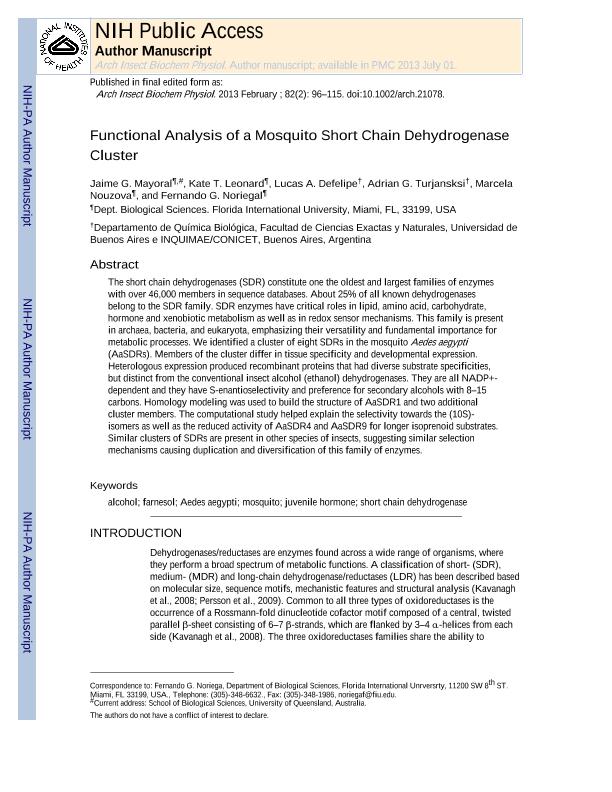Artículo
Functional Analysis Of A Mosquito Short-Chain Dehydrogenase Cluster
Mayoral, Jaime G.; Leonard, Kate T.; Nouzova, Marcela; Noriega, Fernando G.; Defelipe, Lucas Alfredo ; Turjanski, Adrian
; Turjanski, Adrian
 ; Turjanski, Adrian
; Turjanski, Adrian
Fecha de publicación:
02/2013
Editorial:
Wiley-liss, Div John Wiley & Sons Inc
Revista:
Archives Of Insect Biochemistry And Physiology
ISSN:
0739-4462
Idioma:
Inglés
Tipo de recurso:
Artículo publicado
Clasificación temática:
Resumen
The short-chain dehydrogenases (SDR) constitute one of the oldest and largest families of enzymes with over 46,000 members in sequence databases. About 25% of all known dehydrogenases belong to the SDR family. SDR enzymes have critical roles in lipid, amino acid, carbohydrate, hormone, and xenobiotic metabolism as well as in redox sensor mechanisms. This family is present in archaea, bacteria, and eukaryota, emphasizing their versatility and fundamental importance for metabolic processes. We identified a cluster of eight SDRs in the mosquito Aedes aegypti (AaSDRs). Members of the cluster differ in tissue specificity and developmental expression. Heterologous expression produced recombinant proteins that had diverse substrate specificities, but distinct from the conventional insect alcohol (ethanol) dehydrogenases. They are all NADP+-dependent and they have S-enantioselectivity and preference for secondary alcohols with 8-15 carbons. Homology modeling was used to build the structure of AaSDR1 and two additional cluster members. The computational study helped explain the selectivity toward the (10S)-isomers as well as the reduced activity of AaSDR4 and AaSDR9 for longer isoprenoid substrates. Similar clusters of SDRs are present in other species of insects, suggesting similar selection mechanisms causing duplication and diversification of this family of enzymes.
Archivos asociados
Licencia
Identificadores
Colecciones
Articulos(INQUIMAE)
Articulos de INST.D/QUIM FIS D/L MATERIALES MEDIOAMB Y ENERGIA
Articulos de INST.D/QUIM FIS D/L MATERIALES MEDIOAMB Y ENERGIA
Citación
Mayoral, Jaime G.; Leonard, Kate T.; Nouzova, Marcela; Noriega, Fernando G.; Defelipe, Lucas Alfredo; et al.; Functional Analysis Of A Mosquito Short-Chain Dehydrogenase Cluster; Wiley-liss, Div John Wiley & Sons Inc; Archives Of Insect Biochemistry And Physiology; 82; 2; 2-2013; 96-115
Compartir
Altmétricas



